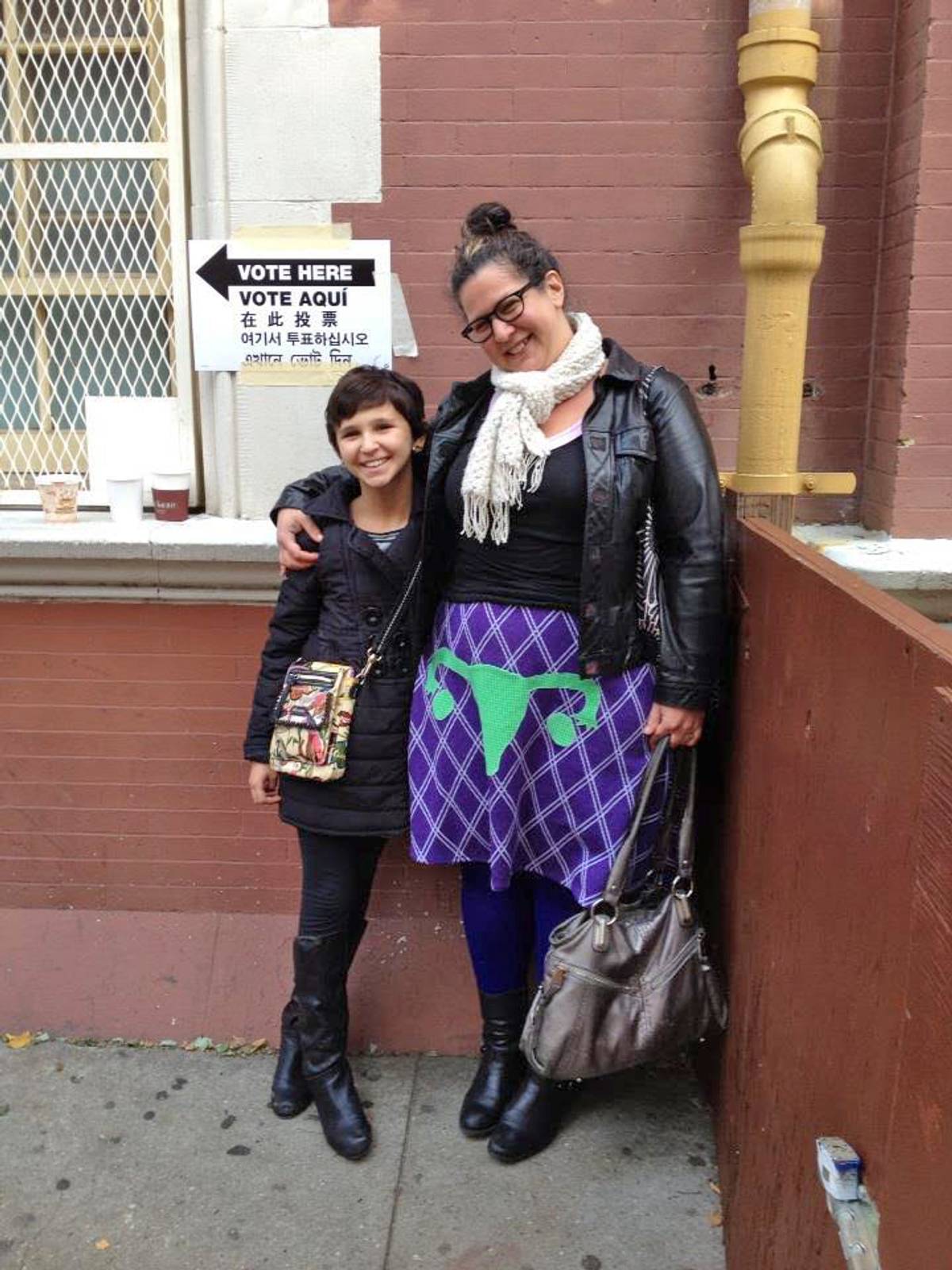News Your Kids Can Use
In the wake of Jon Stewart’s departure, how do we build news-savvy, politically engaged teenagers?




In the zillion hagiographic goodbyes to Jon Stewart last week after his farewell to The Daily Show, two comments stood out for me.
Jewish boyfriend-and-dog-dater Lena Dunham told the New York Times, “Long before I was a person who would ever be on The Daily Show, Jon Stewart was where I got my news. Watching Jon … kept me amused, inspired, and most importantly aware in a time when picking up the newspaper was just not gonna happen.”
And New York Sen. Kirsten Gillibrand said: “He uses comedy well to shine a light on issues that make it clear what’s right and what’s wrong so that his viewers can fully understand it. And for a lot of young viewers, they don’t watch news very often. His take on an issue may be the only resource they have.”
Count me among the many fans sad to say goodbye to Stewart. Not just because his show helped me process and laugh bitterly at the news of the day, but also because it was just starting to be a useful parenting tool. Josie, 13, had just begun to watch with my husband and me. She was especially tickled by Kirsten Schaal’s unhinged vagina humor and feminist savvy and Jessica Williams’ gleeful puncturing of racist and sexist authority. Like any teenager, Josie loves watching power-tripping jerks get taken down a notch and pompous liars getting holes punched in their illogic and hypocrisy.
So, without Stewart and his merry pranksters, will she still pay attention to the news? We’ve all heard the dreying about millennials not watching TV news or reading newspapers, and we’re told they’re disengaged enough from the political process that they stay away from the voting booth. Is this true as well for teenagers like Josie who are too young to vote? As Stewart heads out to cuddle piglets at his New Jersey animal sanctuary, are those of us left behind trying to parse the news with our kids utterly screwed?
***
I started looking for research on whether teenagers care about news and politics and where they get their information. As it turns out, there’s not a lot of data out there, though there’s plenty on those who are one click older, the 18- to 34-year-old generation. Here’s what we know about millennials: According to a 2015 report by the Pew Research Center on Journalism and Media, about 61 percent of them get their political news via Facebook in a given week, while 37 percent watch local news. (Among Baby Boomers, the numbers are almost exactly reversed: 60 percent use local TV as their primary source of information, while 39 percent get their news on Facebook.) Another poll of millennials this year, conducted by the Associated Press-NORC Center for Public Affairs Research and the American Press Institute, found that two-thirds consume news online regularly, most often through a social networking site. Of those, 40 percent do so several times a day.
So, no; for the most part millennials don’t read newspapers or watch evening newscasts. But the survey found that the average young adult regularly uses three or more social media platforms—Facebook, Twitter, YouTube, Tumblr, Reddit—and the youngest in this cohort regularly use four social networking sites, and about 60 percent “bump into” news as they traverse social media. They choose to engage with it as they come across it.
The Daily Show did way better than network news with younger audiences. A 2012 Pew Research Center poll found that 39 percent of Daily Show viewers were 18-29 years old. (The late, lamented Colbert Report’s audience was even younger: 43 percent millennial.) No other news program tested had such a young audience.
Hey, I get it. I would no sooner watch TV news—national or local—than hit myself in the head with a brick. I read the New York Times (mostly online, but thanks to the paper’s confusing-to-me business model, we get the print paper too, because both Jonathan and I want access to the website, which means I get weekend home delivery and he gets it during the week, which is just silly, but OK, that means we clip articles for Josie, which she may or may not read, and I’m done with this parenthetical now). I read articles from dozens of other publications that scroll by me on Twitter and Facebook. I am old, but I apparently read news like a young person! Go, me!
I don’t know how the news business will change as time passes. I do know that we need to do better than the cadaver-pecking news aggregators like Huffington Post that snatch stories from the newspapers and magazines that pay writers and reporters and throw them up on their own websites for clicks. We need to be sure that journalism in war zones, which can be expensive and challenging to report, gets paid for; we need to keep independent journalism alive to afflict the comfortable and keep tabs on big businesses, even if it threatens advertisers and sponsors. We need politically informed and engaged young people, particularly now as we start another presidential campaign cycle, debate a nuclear treaty with Iran, and consider the epidemic of police violence against people of color. Is news from Twitter enough? If younger people don’t want to pay to see ads in their reported features, or pay to read the researched, shoe-leather-fueled journalism they can get free from the aggregating bottom-dwellers, I’m not sure what the future holds.
I asked my friend Christian Ruzich, a vice-president of project consulting at The Futures Company, a youth marketing and research firm, what he could tell me about teenagers’ news-consumption habits. He shared some data from the 2014 TRU Youth Monitor, which “identifies shifts in attitudes and consumer behaviors both by life stage and at the generational level” through data gathered from a nationally representative sample of 4,000 consumers ages 12-29. (The Futures Company calls the post-millennial generation centennials, should you wish to include this in conversation.)
The poll asked: Where do you get political information? Among 12- to 18-year-olds, 55 percent said TV, 43 percent said their parents, 39 percent said social media, 34 percent said school, 33 percent said friends, 32 percent said news sites/apps, 27 percent said social news/entertainment sites like Buzzfeed and Reddit, 25 percent said news aggregators like the Huffington Post, 25 percent said YouTube, 23 percent said newspapers (online or in print), 18 percent said magazines (online or in print), 10 percent said blogs, and 5 percent said other. Ruzich told me that girls are more likely than boys to get their news from social media, social news sites/apps, and blogs; boys are more likely than girls to get their news from YouTube. And interestingly, boys get their news from their parents less as they get older (48 percent for 12- to 15-year-olds, dipping to 34 percent for 18- to 19-year-old boys) while the numbers for girls remain pretty constant (around 45 percent for all age ranges).
It makes sense that girls are more likely to get news via social media. A Pew study found that 62 percent of girls spend time with friends every day via text messaging, compared with 48 percent of boys, and 32 percent of girls spend time with friends every day instant messaging, compared with 23 percent of boys. (Boys are much more likely than girls to interact and spend time with friends while playing video games. Hi, Liel.)
I went to my own source: Josie starts ninth grade this fall. Her first reaction to my question about where she gets her news was: “I don’t pay attention to the news.” But this is wrong. Every time I’ve mentioned a news story to her (most recently, the death of the 16-year-old stabbing victim at the Jerusalem Pride parade), she’s already known about it. She chooses to avoid social media (she tends to be ornery and contrary, and she maintains that she’s just not interested), but she instant-messages and texts constantly with her friends from school and camp. And yes, it seems that they do talk about what’s going on in the world. (“Sarah tells me about feminist outrages,” she informed me.)

But according to The Futures Company’s data, it’s clear that we parents still have a major role to play. We should talk about the news of the day with our kids and let them know what we think. Talk about the news at the dinner table, and share what you think and why. Take your kids to vote with you; model the behavior you want to see. (I always vote wearing my uterus skirt, a fabulous purple knit A-line item with a big green uterus on it. Feel free to comment about how horrifying this is.) Encourage your kids to wrestle with political issues, and know that it’s OK not to have all the answers. We’re fortunate that Josie’s school has a great debate program, and her interest in debate has taught her to argue and answer both sides of a topic. And anything she’s debated—for-profit prisons, gun control, the path to citizenship for undocumented immigrants, whether athletic organizations should be funded with public subsidies, the effectiveness of single-gender classrooms, the benefits and drawbacks of anonymous free speech, the voting rights act—she’s maintained an interest in. It’s our job to talk about these knotty issues with her. And when it comes to specifically Jewish subjects—conflicts between Israelis and Palestinians, the role of the ultra-right in Israel’s future, strategies for stopping terrorism—I need to be sure she knows where I stand. Especially because in the crunchy-granola worlds we travel in, there’s a lot of knee-jerk anti-Israel sentiment … and in the Jewish worlds we travel in, there’s a lot of demonizing of Palestinians.
And we need to tell our future voters that it’s on them to help build the democracy they want to see. According to Pirkei Avot (Ethics of the Fathers), Rabbi Chanina, who reportedly lived in the Galilee at the time of the Second Temple, taught: “Pray for the welfare of the government, for without fear of governmental authorities people would swallow each other alive.” We need to encourage kids to grow up to do their part to keep our government honest as well as protective of its most vulnerable citizens.
In the same text, Rabbi Hillel said, “If I am not for myself, who will be for me? And if I am only for myself, who am I? And if not now, when?” Ronald Reagan quoted these words when pushing through economic reform, and I’d argue that they’re still a good template for talking about politics with kids. Hillel meant that once our own basic needs are taken care of, it’s time to think about the needs of others. Greed and self-absorption are not Jewish values. And telling people to be patient, that justice and rights and equal pay will eventually come, is not helpful. If not now, when? Jon Stewart asked this question when demanding reform of the Veterans Administration, and we should demand the same of ourselves and our kids.
***
Like this article? Sign up for our Daily Digest to get Tablet Magazine’s new content in your inbox each morning.
Marjorie Ingall is a former columnist for Tablet, the author of Mamaleh Knows Best, and a frequent contributor to the New York Times Book Review.